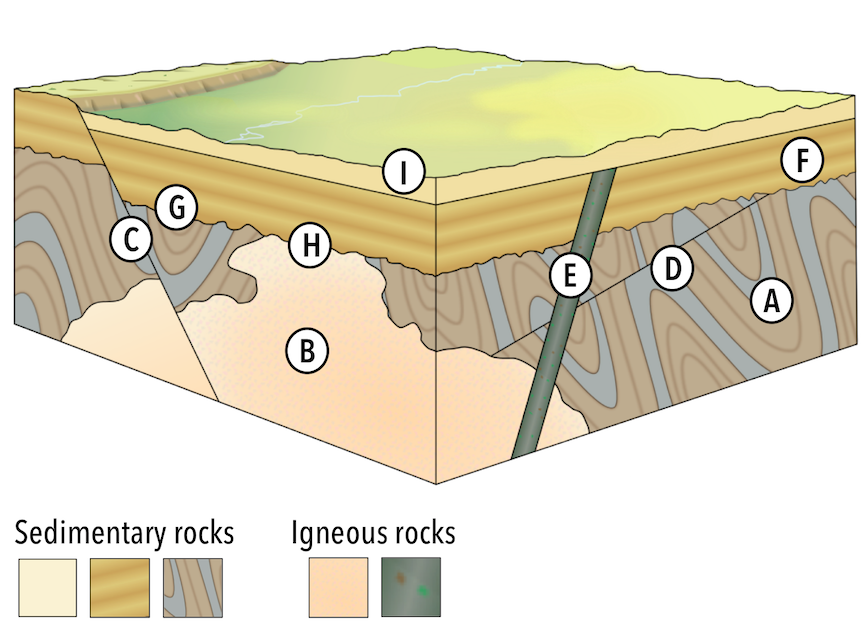19.2 Relative Dating Methods
Relative Dating Principles
The simplest and most intuitive way of dating geological features is to look at the relationships between them. There are a few simple rules for doing this. But caution must be taken, as there may be situations in which the rules are not valid, so local factors must be understood before an interpretation can be made. These situations are generally rare, but they should not be forgotten when unraveling the geological history of an area.
The principle of superposition states that sedimentary layers are deposited in sequence, and the layers at the bottom are older than those at the top. This situation may not be true, though, if the sequence of rocks has been flipped completely over by tectonic processes, or disrupted by faulting.
The principle of original horizontality indicates that sediments are originally deposited as horizontal to nearly horizontal sheets. At a broad scale this is true, but at a smaller scale it may not be. For example, cross-bedding forms at an appreciable angle, where sand is deposited upon the lee face of a ripple. The same holds true of delta foreset beds (Figure 19.6).

The principle of lateral continuity states that sediments are deposited such that they extend laterally for some distance before thinning and pinching out at the edge of the depositional basin. But sediments can also terminate against faults or erosional features (see unconformities below), so may be cut off by local factors.
The principle of inclusions states that any rock fragments that are included in a rock must be older than the rock in which they are included. For example, a xenolith in an igneous rock, or a clast in sedimentary rock must be older than the rock that includes it (Figure 19.7). A possible situation that would violate this principle is the following: an igneous dyke may intrude through a sequence of rocks, hence is younger than these rocks (see the principle of cross-cutting relationships below). Later deformation may cause the dyke to be pulled apart into small pieces, surrounded by the host rocks. This situation can make the pieces of the dyke appear to be xenoliths, but they are younger than the surrounding rock in this case.
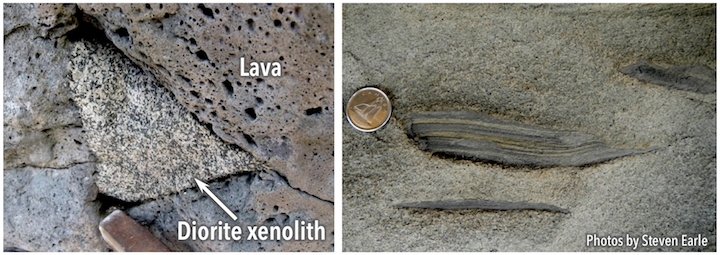
The principle of cross-cutting relationships states that any geological feature that cuts across or disrupts another feature must be younger than the feature that is disrupted. An example of this is given in Figure 19.8, which shows three different sedimentary layers. The lower sandstone layer is disrupted by two faults, so we can infer that the faults are younger than this layer. But the faults do not appear to continue into the coal seam, and they certainly do not continue into the upper sandstone. So we can infer that coal seam is younger than the faults (because the coal seam cuts across them). The upper sandstone is youngest of all, because it lies on top of the coal seam. An example that violates this principle can be seen with a type of fault called a growth fault. A growth fault is a fault that continues to move as sediments are continuously delivered to the hangingwall block. In this case, the lower portion of the fault that cuts the lower sediments may have originally formed before the uppermost sediments were deposited, despite the fault cutting through all of the sediments, and appearing to be entirely younger than all of the sediments.
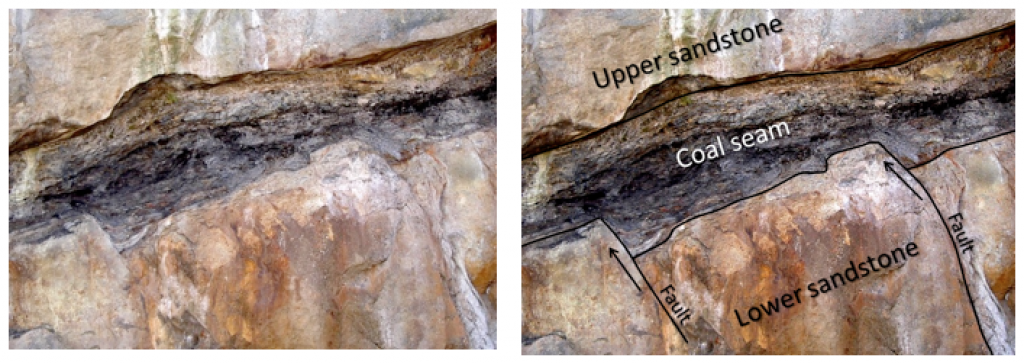
The principle of baked contacts states that the heat of an intrusion will bake (metamorphose) the rocks in close proximity to the intrusion. Hence the presence of a baked contact indicates the intrusion is younger than the rocks around it. If an intrusive igneous rock is exposed via erosion, then later buried by sediments, the surrounding rocks will not be baked, as the intrusion was already cold at the time of sediment deposition. But baked contacts may be difficult to discern, or may be minimally developed to absent when the intrusive rocks are low in volume or felsic (relatively cool) in composition.
The principle of chilled margins states that the portion of an intrusion that has cooled and crystallized next to cold surrounding rock will form smaller crystals than the portion of the intrusion that cooled more slowly deeper in the instrusion, which will form larger crystals. Smaller crystals generally appear darker in colour than larger crystals, so a chilled margin appears as a darkening of the intrusive rock towards the surrounding rock. This principle can be used to distinguish between an igneous sill, which will have a chilled margin at top and bottom, and a subaerial lava flow, which will have a chilled margin only at the bottom.
Exercise: Cross-Cutting Relationships
The outcrop in Figure 19.9 has three main rock types:
- Buff/pink felsic intrusive igneous rock present as somewhat irregular masses trending from lower right to upper left
- Dark grey metamorphosed basalt
- A 50 cm wide light-grey felsic intrusive igneous dyke extending from the lower left to the upper right – offset in several places
Using the principle of cross-cutting relationships outlined above, determine the relative ages of these three rock types.
Note: The near-vertical stripes are blasting drill holes. The image is about 7 m across.
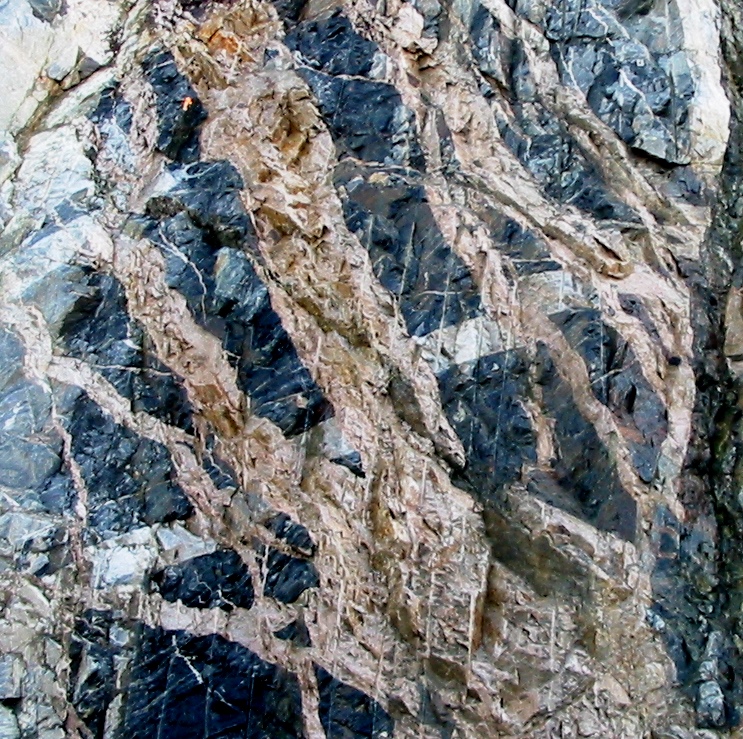
Unconformities
An unconformity represents an interruption in the process of deposition of sediments. Recognizing unconformities is important for understanding time relationships in sedimentary sequences. An unconformity is visible in the Grand Canyon (Figure 19.10, white dashed line) above Proterozoic rocks that were tilted and then eroded to a flat surface prior to deposition of the younger Paleozoic rocks. The difference in time between the youngest of the Proterozoic rocks and the oldest of the Paleozoic rocks is nearly 300 million years. Tilting and erosion of the older rocks took place during this time, and if there were any deposition occurring in this area during this time, erosion removed those sediments.
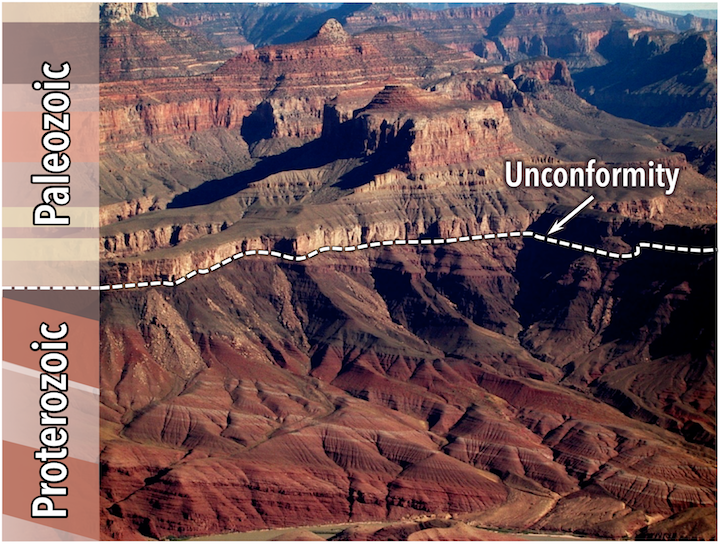
There are four types of unconformities, reflecting different arrangements and types of rocks above and below the surface of non-deposition or erosion (Table 19.1, Figure 19.11).
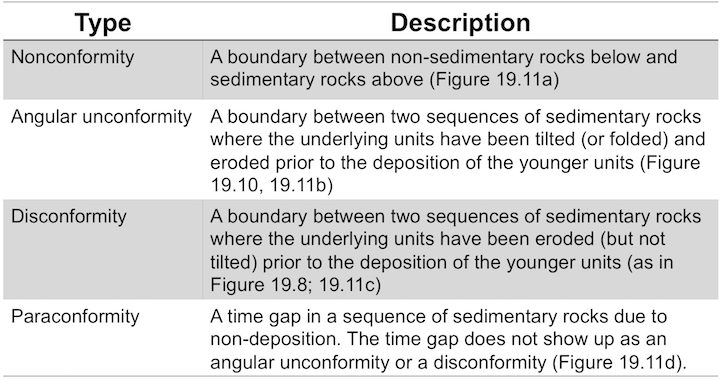
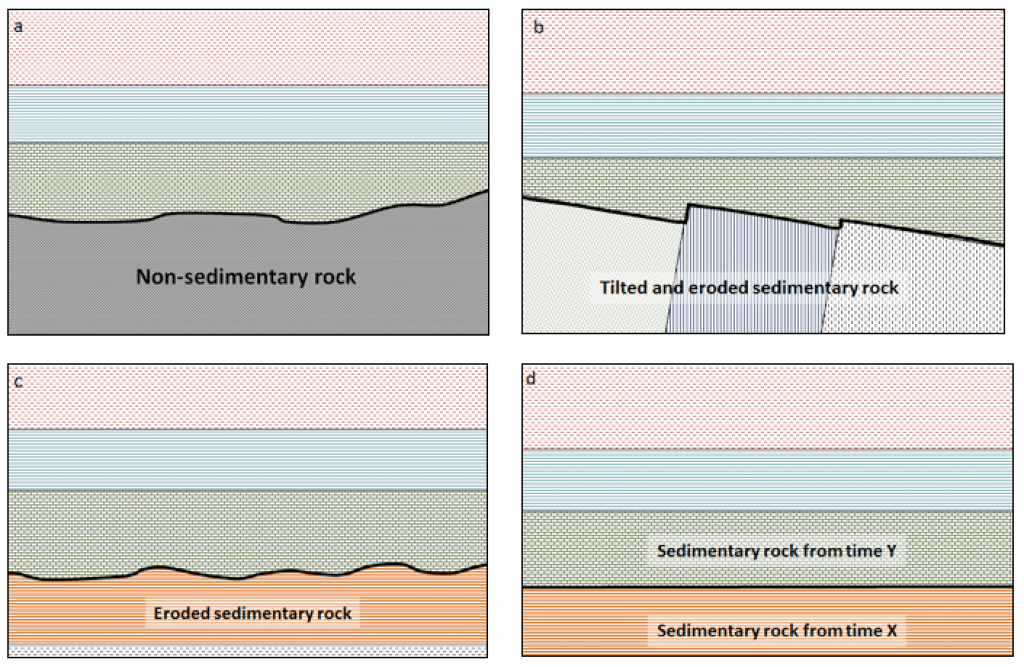
Exercise: Relative Dating with Unconformities
- The surfaces G and H in Figure 19.12 are unconformities. What kind?
- If erosion at the surface stopped and sediments were deposited once again, what kind of unconformity would exist between the layer I and younger rocks?
- Provide a list of the events that affected the rocks in Figure 19.12 in order from the oldest event to the most recent event. Note that C and D are faults. The sedimentary rocks labelled A are folded, but the other sedimentary rocks are horizontal.
